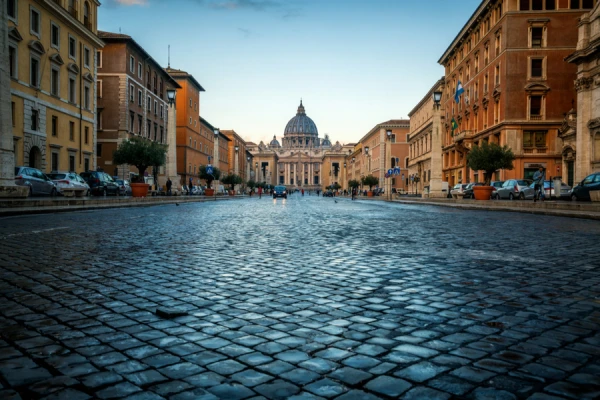
Vatican City, Oct 22, 2019 / 10:00 am (CNA).- The head of the Vatican’s sovereign asset management body has insisted that the Holy See is not headed for financial “collapse.”
Bishop Nunzio Galantino made the comments in response to a book published on Monday by Italian journalist Gianluigi Nuzzi, which claims that the Holy See is facing a serious cash shortage, and may soon be unable to meet its ordinary operating expenses.
“There is no threat of collapse or default here. There is only the need for a spending review. And that is what we’re doing. I can prove it to you with numbers,” Galantino said on Oct. 22.
Galantino is head of the Administration for the Patrimony of the Apostolic See (APSA), which oversees the Vatican’s real estate holdings and other sovereign assets.
“The current situation of the administration of the Holy See is no different from what happens in any family or even in the nations of the different continents. At a certain point one looks at what one spends, considers the revenue that comes in, and tries to adjust expenses accordingly.”
Nuzzi’s book, “Universal Judgment,” claims to be based on some 3,000 pages of confidential documents leaked to him. He reports that annual donations to the Holy See have fallen sharply, by as much as 40% over the last three years – from 100 million euros to 60 million. At the same time, he also says that the Holy See’s property portfolio failed to register a profit last year, the first time ever. The cumulative effect, Nuzzi claims, is an urgent liquidity crisis in the Vatican’s operating finances.
Speaking in response to the book’s publication, Galatino said that no such crisis exists.
“In fact,” he said on Tuesday while claiming that “the ordinary management of the APSA in 2018 closed with a profit of over 22 million euros.”
Galatino said that any reported loss was due to “an extraordinary intervention aimed at saving the operation of a Catholic hospital and the jobs of its employees.”
Nuzzi also claimed that cardinals and high-ranking Vatican officials were operating secret or numbered personal accounts through APSA. A review of the book in the Italian newspaper La Republica quotes Vatican financial investigators as concluding that “the false bottom in Vatican finances is practically non-eliminable.”
Galantino flatly refuted the allegations, saying Tuesday that “I confirm and repeat: APSA has no secret or encrypted accounts. Anyone is welcome to prove the contrary. At APSA, there are also no accounts of physical or juridical persons, except for the dicasteries of the Holy See, related institutions, and the Governorate.”
In an apparent response to recent reports of various Vatican financial deals, including real estate speculation through a Luxembourg-based investment company, the bishop said that management of Vatican assets for a profit is essential to the Holy See’s operations.
“A state that has no taxes or public debt has only two ways to live. Either it invests its own resources to produce an income, or it relies on the contributions of the faithful, even those made to Peter’s Pence,” he said. “Many want the Church to have nothing and then, in any case, to provide fair pay for its workers, as well as to respond to the many needs, first of all those of the poor. It’s obvious that it can’t be like that.”
Galatino conceded that there was a need for a “spending review” but said that this was already underway.
“There is no need for alarmism about the hypothetical default. Rather, we are talking about an entity that is realizing it needs to contain expenses. This happens in any good family or in any serious state”.
The reference by Galatino to an “extraordinary intervention” by APSA appears to be a reference to reports that APSA had written off 30 million of a 50 million euro loan to the Istituto Dermopatico dell’Immacolata, a scandal and corruption hit hospital formerly owned by the Congregation of the Sons of the Immaculate Conception and bought out of government bankruptcy administration by a foundation co-owned by the order and the Vatican Secretariat of State in .
The purchase of the hospital by the non-profit Fondazione Luigi Maria Monti was intended to rescue the hospital from closure and stabilize its operations after years of financial scandals leading to between 400-800 million euros of debt, forcing it into state-administered insolvency.
The hospital was at the center of a public disagreement between the Vatican and the American-based Papal Foundation, which was asked in 2016 to make a grant of $25 million to the hospital to ease liquidity problems.
After the foundation approved the grant in December 2017, an initial $8 million was sent to the Vatican. Subsequently the grant came under intense scrutiny and then opposition from lay trustees and benefactors, who claimed that the size and purpose of the grant was outside of the foundations scope of operations, and that the board had been misled about the financial state of the hospital.
The grant request was later withdrawn by the Holy See at the request of Cardinal Wuerl, who had led the presentation of the plan to the board.
If you value the news and views Catholic World Report provides, please consider donating to support our efforts. Your contribution will help us continue to make CWR available to all readers worldwide for free, without a subscription. Thank you for your generosity!
Click here for more information on donating to CWR. Click here to sign up for our newsletter.





Leave a Reply